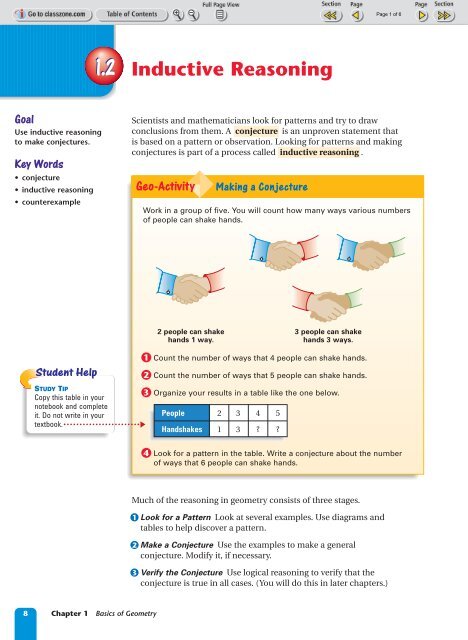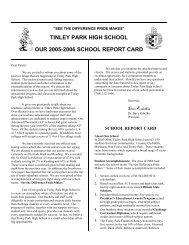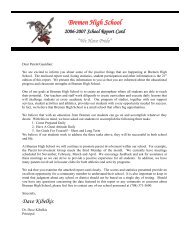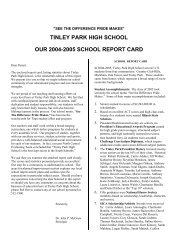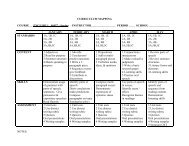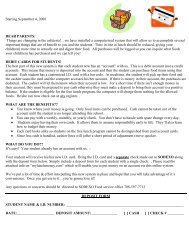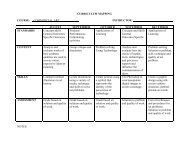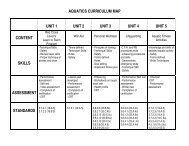Section 1.2
Section 1.2
Section 1.2
You also want an ePaper? Increase the reach of your titles
YUMPU automatically turns print PDFs into web optimized ePapers that Google loves.
<strong>1.2</strong> Inductive Reasoning<br />
Goal<br />
Use inductive reasoning<br />
to make conjectures.<br />
Key Words<br />
• conjecture<br />
• inductive reasoning<br />
• counterexample<br />
Scientists and mathematicians look for patterns and try to draw<br />
conclusions from them. A conjecture is an unproven statement that<br />
is based on a pattern or observation. Looking for patterns and making<br />
conjectures is part of a process called inductive reasoning .<br />
Geo-Activity<br />
Making a Conjecture<br />
Work in a group of five. You will count how many ways various numbers<br />
of people can shake hands.<br />
2 people can shake 3 people can shake<br />
hands 1 way.<br />
hands 3 ways.<br />
Student Help<br />
STUDY TIP<br />
Copy this table in your<br />
notebook and complete<br />
it. Do not write in your<br />
textbook.<br />
●1 Count the number of ways that 4 people can shake hands.<br />
●2 Count the number of ways that 5 people can shake hands.<br />
●3 Organize your results in a table like the one below.<br />
People 2 3 4 5<br />
Handshakes 1 3 ? ?<br />
●4 Look for a pattern in the table. Write a conjecture about the number<br />
of ways that 6 people can shake hands.<br />
Much of the reasoning in geometry consists of three stages.<br />
●1 Look for a Pattern Look at several examples. Use diagrams and<br />
tables to help discover a pattern.<br />
●2 Make a Conjecture Use the examples to make a general<br />
conjecture. Modify it, if necessary.<br />
●3 Verify the Conjecture Use logical reasoning to verify that the<br />
conjecture is true in all cases. (You will do this in later chapters.)<br />
8 Chapter 1 Basics of Geometry
Science<br />
EXAMPLE 1 Make a Conjecture<br />
Complete the conjecture.<br />
Conjecture: The sum of any two odd numbers is __?__.<br />
Solution<br />
Begin by writing several examples.<br />
1 1 2 5 1 6 3 7 10<br />
3 13 16 21 9 30 101 235 336<br />
Each sum is even. You can make the following conjecture.<br />
ANSWER <br />
The sum of any two odd numbers is even.<br />
SCIENTISTS use inductive<br />
reasoning as part of the<br />
scientific method. They<br />
make observations, look for<br />
patterns, and develop<br />
conjectures (hypotheses) that<br />
can be tested.<br />
EXAMPLE 2 Make a Conjecture<br />
Complete the conjecture.<br />
Conjecture: The sum of the first n odd positive integers is __?__.<br />
Solution<br />
List some examples and look for a pattern.<br />
1 1 3 1 3 5 1 3 5 7<br />
1 1 2 4 2 2 9 3 2 16 4 2<br />
ANSWER The sum of the first n odd positive integers is n 2 .<br />
Make a Conjecture<br />
Student Help<br />
READING TIP<br />
Recall that the symbols<br />
and p are two ways<br />
of expressing<br />
multiplication.<br />
Complete the conjecture based on the pattern in the examples.<br />
1. Conjecture: The product of any two odd numbers is __?__.<br />
EXAMPLES<br />
1 1 1 3 5 15 3 11 33<br />
7 9 63 11 11 121 1 15 15<br />
2. Conjecture: The product of the numbers (n 1) and (n 1) is __?__.<br />
EXAMPLES<br />
1 p 3 2 2 1 3 p 5 4 2 1 5 p 7 6 2 1<br />
7 p 9 8 2 1 9 p 11 10 2 1 11 p 13 12 2 1<br />
<strong>1.2</strong> Inductive Reasoning 9
IStudent Help<br />
I CLASSZONE.COM<br />
MORE EXAMPLES<br />
More examples at<br />
classzone.com<br />
Counterexamples Just because something is true for several<br />
examples does not prove that it is true in general. To prove a<br />
conjecture is true, you need to prove it is true in all cases.<br />
A conjecture is considered false if it is not always true. To prove a<br />
conjecture is false, you need to find only one counterexample.<br />
A counterexample is an example that shows a conjecture is false.<br />
EXAMPLE 3 Find a Counterexample<br />
Show the conjecture is false by finding a counterexample.<br />
Conjecture: The sum of two numbers is always greater than the larger<br />
of the two numbers.<br />
Solution<br />
Here is a counterexample. Let the two numbers be 0 and 3.<br />
The sum is 0 3 3, but 3 is not greater than 3.<br />
ANSWER <br />
The conjecture is false.<br />
EXAMPLE 4 Find a Counterexample<br />
Show the conjecture is false by finding a counterexample.<br />
Conjecture: All shapes with four sides the same length are squares.<br />
Solution<br />
Here are some counterexamples.<br />
These shapes have four sides the same length, but they are<br />
not squares.<br />
ANSWER <br />
The conjecture is false.<br />
Find a Counterexample<br />
Show the conjecture is false by finding a counterexample.<br />
3. If the product of two numbers is even, the numbers must be even.<br />
4. If a shape has two sides the same length, it must be a rectangle.<br />
10 Chapter 1 Basics of Geometry
<strong>1.2</strong><br />
Exercises<br />
Guided Practice<br />
Vocabulary Check<br />
1. Explain what a conjecture is.<br />
2. How can you prove that a conjecture is false?<br />
Skill Check<br />
Complete the conjecture with odd or even.<br />
3. Conjecture: The difference of any two odd numbers is __?__.<br />
4. Conjecture: The sum of an odd number and an even number<br />
is __?__.<br />
Show the conjecture is false by finding a counterexample.<br />
5. Any number divisible by 2 is divisible by 4.<br />
6. The difference of two numbers is less than the greater number.<br />
7. A circle can always be drawn around a four-sided shape so that it<br />
touches all four corners of the shape.<br />
Practice and Applications<br />
Extra Practice<br />
See p. 675.<br />
8. Rectangular Numbers The dot patterns form rectangles with a<br />
length that is one more than the width. Draw the next two figures<br />
to find the next two “rectangular” numbers.<br />
2<br />
6<br />
12<br />
20<br />
9. Triangular Numbers The dot patterns form triangles. Draw the<br />
next two figures to find the next two “triangular” numbers.<br />
1<br />
3<br />
6<br />
10<br />
Homework Help<br />
Example 1: Exs. 8−16<br />
Example 2: Exs. 8−16<br />
Example 3: Exs. 17–19<br />
Example 4: Exs. 17–19<br />
Technology Use a calculator to explore the pattern. Write a<br />
conjecture based on what you observe.<br />
10. 101 25 __?__ 11. 11 11 __?__ 12. 3 4 __?__<br />
101 34 __?__ 111 111 __?__ 33 34 __?__<br />
101 49 __?__ 1111 1111 __?__ 333 334 __?__<br />
<strong>1.2</strong> Inductive Reasoning 11
IStudent Help<br />
I CLASSZONE.COM<br />
HOMEWORK HELP<br />
Extra help with problem<br />
solving in Exs. 13–14 is<br />
at classzone.com<br />
Making Conjectures Complete the conjecture based on the pattern<br />
you observe.<br />
13. Conjecture: The product of an odd number and an even number<br />
is __?__.<br />
3 p 6 18 22 p 13 286 43 p 102 4386<br />
5 p 12 60 5 p 2 10 254 p 63 16,002<br />
14 p 9 126 11 p (4) 44<br />
14. Conjecture: The sum of three consecutive integers is always three<br />
times __?__.<br />
3 4 5 3 p 4 6 7 8 3 p 7 9 10 11 3 p 10<br />
4 5 6 3 p 5 7 8 9 3 p 8 10 11 12 3 p 11<br />
5 6 7 3 p 6 8 9 10 3 p 9 11 12 13 3 p 12<br />
15. Counting Diagonals In the shapes below, the diagonals are<br />
shown in blue. Write a conjecture about the number of diagonals<br />
of the next two shapes.<br />
Science<br />
sun<br />
0<br />
2<br />
16. Moon Phases A full moon occurs when the moon is on the<br />
opposite side of Earth from the sun. During a full moon, the<br />
moon appears as a complete circle. Suppose that one year, full<br />
moons occur on these dates:<br />
5<br />
9<br />
Earth’s<br />
orbit<br />
Earth<br />
moon<br />
moon’s<br />
orbit<br />
T F S<br />
S M T 1 2<br />
W 6 7 8 9<br />
10 11 20 21 22 3 4 5 12 13 14 15 16<br />
23<br />
17 18 27 28 29 19 30<br />
24 25 26 31<br />
July<br />
21<br />
Thursday<br />
August<br />
19<br />
Friday<br />
S M T W T F S<br />
1 2 3 4 5 6<br />
7 8 9 10 11 12 13<br />
14 15 16 17 18 19 20<br />
21 22 23 24 25 26 27<br />
28 29 30 31<br />
September<br />
18<br />
Sunday<br />
T F S<br />
S M T W 1 2 3<br />
8 9 10<br />
21 4 11 5 12 13 14 15 22 16 17<br />
23 24<br />
6 7 18 19 20 28 29 30<br />
25 26 27 October<br />
17<br />
Monday<br />
S M T W T F S<br />
1<br />
2 3 4 5 6 7 8<br />
9 10 11 12 13 14 15<br />
16 17 18 19 20 21 22<br />
23 24 25 26 27 28 29<br />
30 31<br />
November<br />
16<br />
Wednesday<br />
F S<br />
S M T 1 W 2 3 10 4 11 12<br />
T 5<br />
19<br />
6 13 7 14 15 22 16 23 24 25 8 9 17 18 26<br />
20 29 30<br />
21 27 28 December<br />
15<br />
Thursday<br />
S M T W T F S<br />
1 2 3<br />
4 5 6 7 8 9 10<br />
11 12 13 14 15 16 17<br />
18 19 20 21 22 23 24<br />
25 26 27 28 29 30 31<br />
Not drawn to scale<br />
FULL MOONS happen when<br />
Earth is between the moon<br />
and the sun.<br />
Application Links<br />
CLASSZONE.COM<br />
Determine how many days are between these full moons and<br />
predict when the next full moon occurs.<br />
Error Analysis Show the conjecture is false by finding a<br />
counterexample.<br />
17. Conjecture: If the product of two numbers is positive, then the<br />
two numbers must both be positive.<br />
18. Conjecture: All rectangles with a perimeter of 20 feet have the<br />
same area. Note: Perimeter 2(length width).<br />
19. Conjecture: If two sides of a triangle are the same length, then the<br />
third side must be shorter than either of those sides.<br />
12 Chapter 1 Basics of Geometry
20. Telephone Keypad Write a conjecture about the letters you<br />
expect on the next telephone key. Look at a telephone to see<br />
whether your conjecture is correct.<br />
21. Challenge Prove the conjecture below by writing a variable<br />
statement and using algebra.<br />
Conjecture: The sum of five consecutive integers is always<br />
divisible by five.<br />
x (x 1) (x 2) (x 3) (x 4) __?__<br />
Standardized Test<br />
Practice<br />
22. Multiple Choice Which of the following is a counterexample of<br />
the conjecture below?<br />
Conjecture: The product of two positive numbers is always<br />
greater than either number.<br />
A 2, 2 B 1 2 , 2 C 3, 10 D 2, 1<br />
23. Multiple Choice You fold a large piece of paper in half four times,<br />
then unfold it. If you cut along the fold lines, how many identical<br />
rectangles will you make?<br />
F 4 G 8 H 16 J 32<br />
Mixed Review<br />
Describing Patterns Sketch the next figure you expect in the<br />
pattern. (Lesson 1.1)<br />
24. 25.<br />
1<br />
Y<br />
X<br />
Z<br />
2<br />
3<br />
Algebra Skills<br />
Using Integers Evaluate. (Skills Review, p. 663)<br />
26. 8 (3) 27. 2 9 28. 9 (1) 29. 7 3<br />
30. 3(5) 31. (2)(7) 32. 20 (5) 33. (8) (2)<br />
Evaluating Expressions Evaluate the expression when x 3.<br />
(Skills Review, p. 670)<br />
34. x 7 35. 5 x 36. x 9 37. 2x 5<br />
38. x 2 6 39. x 2 4x 40. 3x 2 41. 2x 3<br />
<strong>1.2</strong> Inductive Reasoning 13


